Introduction
In the fast-evolving agricultural sector, farmers require reliable financial support to keep their operations thriving.
This is where loan options for farmers come into play.
These financial tools are critical for enabling farmers to invest in new equipment, expand their businesses, and navigate through the various challenges that they face.
Importance of loan options for farmers
The importance of loan options for farmers cannot be overstated.
Providing access to affordable capital allows farmers to adapt to changing market conditions, modernize their practices, and remain competitive.
Furthermore, these loans help drive economic growth in rural communities, create jobs, and ensure food security for the nation.
Looking ahead to 2024, it is essential to assess the landscape of loan options available to farmers.
With advancements in technology and increased focus on sustainable farming practices, farmers need innovative financial solutions tailored to their specific needs.
Whether it’s low-interest loans, government subsidies, or specialized credit programs, farmers require a range of options to choose from.
Overview of the article’s purpose
This article aims to explore the loan options that farmers can expect in 2024.
By understanding the evolving financial landscape, farmers can make informed decisions about the loans that will best suit their needs.
It is crucial for farmers, policymakers, and financial institutions to work collaboratively to ensure that farmers have access to the necessary capital to prosper in the coming years.
In the following sections, we will delve into the different loan options available, the eligibility criteria, and the potential challenges that farmers may face in accessing these loans.
By staying informed about the evolving loan options, farmers can secure the financial support they need to thrive in an ever-changing agricultural landscape.
Current Loan Options for Farmers
In 2024, farmers have a range of loan options available to meet their financial needs.
Transform Your Agribusiness
Unlock your farm's potential with expert advice tailored to your needs. Get actionable steps that drive real results.
Get StartedThis section discusses the current loan options, focusing on traditional banks and credit unions, as well as government programs and subsidies.
Traditional banks and credit unions
Traditional banks and credit unions have been a long-standing source of loans for farmers.
They offer both advantages and disadvantages.
- Pros and cons: Farmers opting for loans from traditional banks benefit from established institutions and a wide range of financial services. However, the loan application process can be time-consuming and involve strict eligibility criteria.
- Interest rates and repayment terms: Farmers should carefully consider the interest rates offered by banks and credit unions. Repayment terms can vary, so farmers must ensure that they align with their cash flow and income patterns.
While traditional banks and credit unions provide reliable loan options, farmers should explore alternative sources of financing.
Government programs and subsidies
Government programs and subsidies aimed at supporting farmers can provide additional loan options.
Understanding the available options and the eligibility criteria is crucial for farmers.
- Available options: Farmers have access to various government programs, such as agricultural loans, disaster assistance loans, and farm ownership loans. These programs cater to different needs and circumstances.
- Eligibility criteria: Each government program has specific criteria that farmers must meet to qualify for loans or subsidies. These criteria may include factors like income level, farming experience, and adherence to environmentally sustainable practices.
It is essential for farmers to research and understand the different government programs and subsidies available to them.
These programs can provide valuable financial support and help farmers achieve their goals.
Therefore, farmers in 2024 have several loan options to choose from.
Traditional banks and credit unions offer reliable loan services, although they come with their own pros and cons.
Government programs and subsidies provide additional opportunities but require farmers to meet specific eligibility criteria.
By exploring all available loan options, farmers can make informed decisions about their financing needs and secure the necessary funds to support their agricultural operations.
Read: Budgeting Best Practices in Agribusiness

Emerging Loan Options in 2024
The year 2024 brings forth new and exciting loan options for farmers, revolutionizing the way they access capital.
In this section, we will explore two emerging loan options and their potential benefits for farmers.
Online lending platforms
The rise of technology has paved the way for convenient and efficient online lending platforms.
These platforms offer a range of advantages and disadvantages for farmers.
One significant advantage of online lending platforms is the convenience they offer.
Farmers can access funds from the comfort of their homes, eliminating the need to visit physical bank branches.
This accessibility ensures that farmers can quickly secure the funds they require to maintain their agricultural operations.
In addition to convenience, online lending platforms provide farmers with a wide range of options.
They can compare loan terms, interest rates, and repayment options across multiple platforms, enabling them to select the most favorable terms for their specific circumstances.
Such flexibility empowers farmers to make informed decisions and effectively manage their financial obligations.
However, it is essential to consider the potential disadvantages of online lending platforms.
Showcase Your Farming Business
Publish your professional farming services profile on our blog for a one-time fee of $200 and reach a dedicated audience of farmers and agribusiness owners.
Publish Your ProfileOne significant drawback is the possibility of higher interest rates compared to traditional bank loans.
Farmers should carefully assess the interest rates offered by online platforms to ensure they can manage the associated costs effectively.
Moreover, farmers must exercise caution and verify the legitimacy of online lending platforms.
While there are reputable platforms available, the prevalence of online scams highlights the need for thorough research and due diligence before entrusting personal and financial information to any platform.
In summary, online lending platforms offer farmers the advantages of convenience and variety.
However, farmers must also be aware of the drawbacks and exercise caution to avoid falling victim to scams.
Peer-to-peer lending
Another loan option gaining traction in 2024 is peer-to-peer lending.
This innovative concept allows individuals to lend money directly to others through online platforms, bypassing traditional financial institutions.
The primary advantage of peer-to-peer lending for farmers is the potential for lower interest rates.
By eliminating intermediaries like banks, borrowers can negotiate loans directly with individuals who might offer more favorable terms.
Lower interest rates can significantly reduce the financial burden on farmers, making it easier for them to invest in their farms and improve their agricultural practices.
Furthermore, peer-to-peer lending provides an opportunity to access capital without extensive collateral requirements.
Banks often demand significant collateral to secure loans, making it challenging for farmers with limited or non-traditional assets to obtain financing.
Peer-to-peer lending allows farmers to present their business plans and establish trust with lenders who may prioritize the overall viability of their agricultural projects.
Additionally, the peer-to-peer lending model fosters community support.
People who invest in local farmers through this system contribute to the growth and sustainability of their communities.
Farmers can establish meaningful connections with lenders, amplifying the impact of their funding beyond financial support.
Basically, peer-to-peer lending presents a promising loan option for farmers in 2024.
Its potential for lower interest rates, reduced collateral requirements, and community engagement makes it a compelling choice for farmers seeking flexibility in accessing capital.
In this section, we explored the emerging loan options of online lending platforms and peer-to-peer lending.
These advancements in the financial landscape provide farmers with more choices and flexibility when it comes to meeting their financial needs.
However, farmers must remain vigilant and conduct thorough research to maximize the benefits and mitigate potential risks associated with these loan options.
Read: 2024 Guide: Accessing Agri-Finance Aid
Implications of New Loan Options
As farmers navigate the new loan options available in 2024, there are both potential challenges and opportunities to consider.
Understanding the implications of these alternatives is crucial for the success and sustainability of agricultural businesses.
Potential challenges for farmers
One potential challenge that farmers may face is a lack of awareness and understanding about the new loan options.
As financial institutions introduce new products and services, it is essential for farmers to stay informed and comprehend the intricacies of these offerings.
Without proper understanding, they may miss out on opportunities to leverage these loans effectively.
Additionally, farmers may encounter differences in interest rates and terms among various loan options.
This can make it difficult for them to compare and choose the most suitable option for their specific needs.
Farmers must carefully consider the terms, interest rates, and repayment schedules to ensure that they select a loan that aligns with their long-term financial goals and capabilities.
Opportunities for growth and diversification
Despite the potential challenges, farmers can also benefit from the new loan options available in 2024.
One significant advantage is increased access to capital for small-scale farmers.
Many traditional lenders have historically been reluctant to provide loans to smaller agricultural businesses due to perceived risks.
However, the introduction of new loan options can bridge this gap and provide smaller farmers with the much-needed funding to expand their operations and invest in modern technologies.
An additional opportunity brought about by new loan options is increased competition among financial institutions.
As more lenders offer specialized loans for farmers, competition intensifies.
This heightened competition can result in improved loan terms, making it more advantageous for farmers to seek funding.
Lower interest rates, flexible repayment options, and favorable grace periods can all contribute to better financial outcomes for farmers.
In essence, while the introduction of new loan options for farmers in 2024 brings potential challenges, such as a lack of awareness and varying interest rates, it also presents exciting opportunities for growth and diversification.
Showcase Your Farming Business
Publish your professional farming services profile on our blog for a one-time fee of $200 and reach a dedicated audience of farmers and agribusiness owners.
Publish Your ProfileFarmers must stay informed, compare options carefully, and select those loans which best align with their unique needs and long-term objectives.
By making the most of these loan options, farmers can secure the capital necessary for a successful and sustainable future in agriculture.
Read: AI in Farming: Boosting Agri-Business Profits
Learn More: Agri-Tech for Sustainable Farming Practices
Future Outlook for Loan Options in Agriculture
Predictions and trends in farming loans
The future of loan options in agriculture looks promising, with several predictions and trends shaping the industry.
Two key factors that will shape the future of farming loans are technological advancements and economic and policy factors.
Technological advancements in farming are expected to have a significant impact on loan options.
With the rise of precision agriculture, farmers now have access to advanced machinery, sensors, and data analytics that can improve efficiency and productivity.
These technologies require substantial investments, and farming loans will evolve to accommodate these needs.
Lenders may offer specialized loans for purchasing and maintaining high-tech equipment and systems.
Economic and policy factors will continue to influence loan options for farmers.
Government regulations, trade agreements, and market conditions can affect the profitability of farming operations.
Loan options will need to be flexible and responsive to these changing factors.
Lenders may offer variable interest rates, loan restructuring options, and insurance products to minimize risks associated with economic uncertainties.
Role of financial institutions and government programs
Financial institutions and government programs will play a crucial role in supporting farmers’ financial needs and fostering sustainable agriculture practices.
Financial institutions will need to adapt their loan products to meet the evolving needs of farmers.
As farming practices and technologies change, lenders must understand the unique challenges and opportunities faced by farmers.
They can develop loan options tailored to specific needs, such as loans for organic farming, renewable energy projects, or sustainable irrigation systems.
Additionally, lenders may offer flexible repayment terms, seasonal payment schedules, and grace periods during low-profitability periods.
Government programs will continue to support sustainable agriculture practices through loan options.
As the global focus on sustainability grows, governments are incentivizing farmers to adopt environmentally friendly practices.
Loan programs with low-interest rates, grants, and subsidies are being designed to encourage investment in sustainable agriculture.
These programs can help offset the costs of transitioning to organic farming, implementing efficient irrigation systems, or adopting renewable energy solutions.
In fact, the future outlook for loan options in agriculture is promising.
Technological advancements and economic factors will shape the availability and features of farming loans.
Financial institutions will need to adapt their products to meet the changing needs of farmers, while government programs will play a crucial role in supporting sustainable agriculture practices.
By staying abreast of these trends and collaborations between financial institutions and governments, farmers can access the necessary financial resources to thrive in the evolving agricultural landscape.
Read: Farm Finance Planning: 2024 Essentials
Conclusion
In the ever-evolving realm of agricultural finance in 2024, a spectrum of loan options has been unveiled, offering tailored solutions for farmers.
Summarizing the key takeaways:
Diverse Loan Options
- Explored the array of loans available, from equipment financing to operational expenses.
- Each loan type caters to specific needs, providing flexibility in financial choices.
Encouragement for Farmers to Explore Their Loan Options
- Empowering Farmers: The section encourages farmers to delve into the diverse landscape of available loans.
- Informed Decision-Making: A call to make well-informed decisions ensures that farmers secure optimal financial support for their unique requirements.
Importance of Staying Updated with Changing Financial Landscape in Agriculture
- Adaptive Strategies: Recognizing the financial landscape’s dynamic nature, farmers are urged to adapt their strategies accordingly.
- Future Preparedness: Staying informed not only allows for proactive adjustments but also ensures sustained success in agricultural operations.
The world of farm finance in 2024 offers a rich tapestry of options for farmers.
Exploring these choices, making informed decisions, and staying attuned to the changing financial dynamics are key to navigating the financial landscape and securing a prosperous future for agricultural endeavors.




